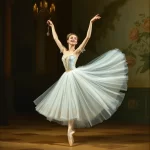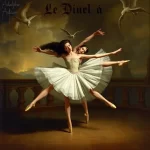Ballet: Coppélia (Léo Delibes, 1870)

Introduction
Ballet, a classical dance form known for its grace and precision, has produced numerous masterpieces over the centuries. One such enduring work is “Coppélia,” a ballet composed by Léo Delibes and choreographed by Arthur Saint-Léon. Premiering on May 25, 1870, at the Théâtre Impérial de l’Opéra in Paris, “Coppélia” is a delightful blend of comedy, romance, and fantasy. The ballet tells the story of a life-like doll, Coppélia, and the humorous misunderstandings that ensue when a young villager, Franz, becomes infatuated with her, much to the dismay of his fiancée, Swanilda.
Historical Background
Creation and Development
“Coppélia” was created during a period of significant artistic and social change in Europe. The late 19th century saw the rise of Romanticism, which emphasized emotion, individualism, and the glorification of the past and nature. This cultural movement influenced many art forms, including ballet. The inspiration for “Coppélia” came from E.T.A. Hoffmann’s short story “Der Sandmann” (“The Sandman”), which explores themes of reality versus illusion and the uncanny.
The collaboration between choreographer Arthur Saint-Léon and composer Léo Delibes was crucial to the ballet’s success. Saint-Léon, known for his innovative choreography, sought to create a ballet that combined technical prowess with engaging storytelling. Delibes, a composer celebrated for his melodic inventiveness, provided a score that perfectly complemented Saint-Léon’s vision. Together, they crafted a ballet that was both entertaining and artistically significant.
Premiere and Reception
“Coppélia” premiered on May 25, 1870, at the Théâtre Impérial de l’Opéra in Paris. The initial reception was overwhelmingly positive, with both critics and audiences praising the ballet’s charm, humor, and technical brilliance. Notable early performances included those by the original cast, featuring Giuseppina Bozzacchi as Swanilda and Eugénie Fiocre as Franz. The ballet quickly became a staple of the repertoire, with numerous revivals and adaptations over the years.
Synopsis of the Ballet
Act I Summary
The ballet opens in a quaint village square, where the townspeople are preparing for a festival. Swanilda and Franz, a young couple, are introduced. Franz, however, becomes distracted by a beautiful girl sitting on a balcony, who he believes to be the daughter of Dr. Coppélius, a mysterious toymaker. Swanilda is upset by Franz’s infatuation and decides to investigate. The act ends with Swanilda and her friends sneaking into Dr. Coppélius’s workshop.
Act II Summary
Inside the workshop, Swanilda and her friends discover that the girl on the balcony is actually a life-like doll named Coppélia. Dr. Coppélius returns and, unaware of the intruders, begins his experiments to bring Coppélia to life. Swanilda, hiding in the workshop, decides to impersonate the doll. When Dr. Coppélius attempts to use Franz’s life force to animate Coppélia, Swanilda reveals herself, and the villagers burst in to rescue Franz. The act concludes with Dr. Coppélius realizing his dream of bringing Coppélia to life is shattered.
Act III Summary
The final act takes place during the village festival. Swanilda and Franz reconcile, and the villagers celebrate with various dances. Dr. Coppélius is appeased with a monetary compensation for the damages to his workshop. The ballet concludes with a joyful wedding ceremony for Swanilda and Franz, symbolizing the triumph of love and reality over illusion.
Finale
The conclusion of “Coppélia” is significant as it reinforces the themes of love, forgiveness, and the distinction between reality and fantasy. The joyous celebration and the union of Swanilda and Franz bring the ballet to a satisfying and heartwarming close.
Musical Composition
Composer’s Role
Léo Delibes, a prominent French composer, played a pivotal role in the creation of “Coppélia.” Known for his ability to craft memorable melodies and rich orchestration, Delibes’s score for “Coppélia” is considered one of his finest works. The music is characterized by its lively rhythms, charming melodies, and the effective use of leitmotifs to represent different characters and themes.
Musical Themes and Motifs
The score of “Coppélia” features several recurring musical themes that enhance the narrative and emotional depth of the ballet. For instance, the playful and whimsical motifs associated with Swanilda and her friends contrast with the more mysterious and mechanical themes representing Dr. Coppélius and his workshop. Delibes’s music effectively captures the humor, romance, and fantasy elements of the story, making it an integral part of the ballet’s success.
Famous Recordings and Performances
Over the years, “Coppélia” has been recorded and performed by numerous renowned orchestras and ballet companies. Notable recordings include those by the Royal Opera House Orchestra, conducted by Mark Ermler, and the Paris Opera Ballet Orchestra, conducted by Jean-Baptiste Mari. These recordings highlight the enduring appeal and musical brilliance of Delibes’s score.
Choreography and Dance
Choreographer’s Vision
Arthur Saint-Léon, the original choreographer of “Coppélia,” was known for his innovative approach to ballet. His vision for “Coppélia” was to create a work that combined technical excellence with engaging storytelling. Saint-Léon’s choreography is characterized by its intricate footwork, expressive mime, and the seamless integration of character-driven dance sequences.
Signature Dance Numbers
“Coppélia” features several signature dance numbers that have become iconic in the world of ballet. The “Mazurka” and “Czardas” in Act I are lively folk dances that showcase the technical prowess of the dancers. The “Waltz of the Hours” in Act III is a beautiful ensemble piece that highlights the grace and elegance of the corps de ballet. The Pas de Deux between Swanilda and Franz is a highlight of the ballet, reflecting their love and reconciliation.
Notable Interpretations
Over the years, different productions of “Coppélia” have brought unique interpretations to the choreography. Some productions have emphasized the comedic elements, while others have focused on the romantic and fantastical aspects. Notable interpretations include those by the Bolshoi Ballet, the Royal Ballet, and the Paris Opera Ballet, each bringing their own style and flair to the classic choreography.
Characters and Roles
Main Characters
- Swanilda: The heroine of the ballet, Swanilda is a spirited and resourceful young woman who ultimately wins back her fiancé, Franz.
- Franz: Swanilda’s fiancé, who becomes infatuated with the doll Coppélia, leading to a series of humorous misunderstandings.
- Dr. Coppélius: A mysterious toymaker who dreams of bringing his life-like doll, Coppélia, to life.
Supporting Characters
- Coppélia: The life-like doll created by Dr. Coppélius, who becomes the object of Franz’s infatuation.
- Villagers: The townspeople who participate in the festival and various dances throughout the ballet.
Famous Dancers
Many renowned dancers have portrayed the roles in “Coppélia” over the years. Notable Swanildas include Alicia Markova, Margot Fonteyn, and Natalia Osipova. Famous Franzs include Rudolf Nureyev, Mikhail Baryshnikov, and Roberto Bolle. These dancers have brought their own interpretations and technical brilliance to the roles, contributing to the ballet’s enduring popularity.
Cultural and Artistic Impact
Influence on Ballet and Dance
“Coppélia” has had a significant influence on the world of ballet and dance. Its successful blend of comedy, romance, and technical skill set a new standard for narrative ballets. The ballet’s emphasis on character-driven storytelling and expressive mime has inspired many choreographers and dancers in subsequent works.
Cultural Significance
The cultural significance of “Coppélia” extends beyond the world of ballet. The story’s themes of reality versus illusion and the humorous exploration of human folly have resonated with audiences for over a century. The ballet has been adapted into various forms, including film, theater, and literature, further cementing its place in popular culture.
Legacy and Revivals
“Coppélia” continues to be performed and celebrated around the world. Major revivals by leading ballet companies, such as the Bolshoi Ballet, the Royal Ballet, and the Paris Opera Ballet, have kept the ballet fresh and relevant for new generations of audiences. Modern adaptations and reinterpretations have also brought new perspectives to the classic work, ensuring its enduring legacy.
Iconic Productions
Historic Productions
Some of the most famous historical productions of “Coppélia” include those by the original Paris Opera Ballet in 1870, the Bolshoi Ballet in the early 20th century, and the Royal Ballet in the mid-20th century. These productions featured key figures such as choreographers Marius Petipa and Enrico Cecchetti, who contributed to the ballet’s enduring success.
Contemporary Productions
Recent productions of “Coppélia” have brought new interpretations and innovations to the classic ballet. Companies like the American Ballet Theatre, the Australian Ballet, and the Mariinsky Ballet have staged contemporary versions that highlight different aspects of the story and choreography. These productions often incorporate modern set and costume designs, adding a fresh visual appeal to the timeless tale.
Production Design
The set, costume, and lighting design in various productions of “Coppélia” play a crucial role in bringing the story to life. Traditional designs often feature quaint village scenes, whimsical toy workshops, and elaborate festival settings. Modern productions may experiment with more abstract or minimalist designs, but the essence of the story remains intact. The use of lighting to create mood and highlight key moments is also a significant aspect of the production design.
Critical Reception and Reviews
Initial Critical Response
At the time of its premiere, “Coppélia” received glowing reviews from critics. They praised the ballet’s charming story, delightful music, and innovative choreography. The combination of humor, romance, and technical brilliance was seen as a refreshing addition to the ballet repertoire.
Modern Reviews
Contemporary critics and audiences continue to hold “Coppélia” in high regard. Modern reviews often highlight the ballet’s timeless appeal, its engaging characters, and the enduring beauty of Delibes’s score. The ballet’s ability to entertain and captivate audiences of all ages is frequently noted as a reason for its lasting popularity.
Fun Facts and Trivia
Behind-the-Scenes Stories
One interesting anecdote from the original production of “Coppélia” involves Giuseppina Bozzacchi, the first Swanilda. Tragically, Bozzacchi passed away at the age of 17, just months after the ballet’s premiere, due to illness. Her untimely death added a poignant note to the ballet’s early history.
Notable Performers
Over the years, many famous dancers, conductors, and directors have been associated with “Coppélia.” Notable performers include Alicia Markova, who brought a new level of technical skill to the role of Swanilda, and Rudolf Nureyev, whose portrayal of Franz was celebrated for its charisma and athleticism.
Trivia
- “Coppélia” is often referred to as “The Girl with the Enamel Eyes” due to the doll’s life-like appearance.
- The ballet’s score includes a famous “Waltz of the Hours,” which has been used in various other media and performances.
- “Coppélia” was one of the first ballets to feature a strong female lead character who drives the narrative forward.
Conclusion
Summary of the Ballet’s Importance
“Coppélia” holds a significant place in the world of ballet due to its delightful blend of humor, romance, and technical brilliance. The collaboration between Léo Delibes and Arthur Saint-Léon resulted in a work that has captivated audiences for over a century. Its engaging story, memorable music, and innovative choreography have made it a beloved classic.
Final Thoughts
Reflecting on “Coppélia,” it is clear why this ballet has endured as a favorite among dancers and audiences alike. Its timeless themes, charming characters, and beautiful music continue to resonate with people of all ages. For those who have not yet experienced “Coppélia,” watching a performance or listening to the score is highly recommended. It is a testament to the enduring power of ballet as an art form.
FAQ
What is the central theme of this ballet?
The central theme of “Coppélia” is the distinction between reality and illusion, explored through a humorous and romantic narrative.
Who are the main characters in this ballet?
The main characters are Swanilda, Franz, and Dr. Coppélius. Swanilda is the heroine, Franz is her fiancé, and Dr. Coppélius is a mysterious toymaker.
What is the most famous dance number in this ballet?
One of the most famous dance numbers in “Coppélia” is the “Waltz of the Hours,” a beautiful ensemble piece in Act III.
How long does a typical performance of this ballet last?
A typical performance of “Coppélia” lasts approximately two hours, including intermissions.
Are there any modern adaptations of this ballet?
Yes, there are several modern adaptations of “Coppélia,” including contemporary productions by leading ballet companies that bring new interpretations to the classic work.
Why is this ballet considered important in the history of dance?
“Coppélia” is considered important in the history of dance due to its successful blend of narrative, humor, and technical skill. It set a new standard for character-driven storytelling in ballet and has influenced many subsequent works.





